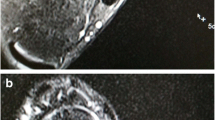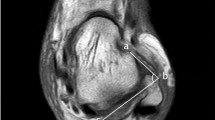Abstract
Objective
To determine T2* normal reference values for anterior talofibular ligament (ATFL) and to investigate the feasibility of the quantitative ATFL quality evaluation in chronic lateral ankle instability (CLAI) using T2* values.
Materials and methods
This study enrolled 15 patients with CLAI and 30 healthy volunteers. The entire ATFL T2* values from the MRI T2* mapping were measured. The prediction equation (variables: age, height, and weight) in a multiple linear regression model was used to calculate the T2* normal reference value in the healthy group. T2* ratio was defined as the ratio of the actual T2* value of the patient’s ATFL to the normal reference value for each patient. A Telos device was used to measure the talar tilt angle (TTA) from the stress radiograph.
Results
T2* values of ATFL in the healthy and CLAI groups were 10.82 ± 1.84 ms and 14.36 ± 4.30 ms, respectively, which are significantly higher in the CLAI group (P < 0.05). The prediction equation of the normal reference T2* value was [14.9 + 0.14 × age (years) − 4.7 × height (m) − 0.03 × weight (kg)] (R2 = 0.65, P < 0.0001). A significant positive correlation was found between the T2* ratio and TTA (r = 0.66, P = 0.007).
Conclusion
MRI T2* values in patients with CLAI were higher than those in healthy participants, and the T2* ratio correlated with TTA, suggesting that T2* values are promising for quantitative assessment of ATFL quality preoperatively.






Similar content being viewed by others
Data Availability
The data that support the findings of this study are available from the corresponding author, AT, upon reasonable request.
References
Doherty C, Delahunt E, Caulfield B, Hertel J, Ryan J, Bleakley C. The incidence and prevalence of ankle sprain injury: a systematic review and meta-analysis of prospective epidemiological studies. Sports Med. 2014;44(1):123–40.
Waterman BR, Owens BD, Davey S, Zacchilli MA, Belmont PJ Jr. The epidemiology of ankle sprains in the United States. J Bone Joint Surg Am. 2010;92(13):2279–84.
Matsui K, Takao M, Miyamoto W, Matsushita T. Early recovery after arthroscopic repair compared to open repair of the anterior talofibular ligament for lateral instability of the ankle. Arch Orthop Trauma Surg. 2016;136(1):93–100.
Michels F, Pereira H, Calder J, et al. Searching for consensus in the approach to patients with chronic lateral ankle instability: ask the expert. Knee Surg Sports Traumatol Arthrosc. 2018;26(7):2095–102.
Dierckman BD, Ferkel RD. Anatomic reconstruction with a semitendinosus allograft for chronic lateral ankle instability. Am J Sports Med. 2015;43(8):1941–50.
Akatsuka Y, Teramoto A, Takashima H, Watanabe K, Yamashita T. Morphologicalevaluation of the calcaneofibular ligament in different ankle positions using a three-dimensional MRI sequence. Surg Radiol Anat. 2019;41(3):307–11.
Teramoto A, Akatsuka Y, Takashima H, et al. 3D MRI evaluation of morphological characteristics of lateral ankle ligaments in injured patients and uninjured controls. J Orthop Sci. 2020;25(1):183–7.
Yi J, Lee YH, Hahn S, Albakheet SS, Song H-T, Suh J-S. Fast isotropic volumetric magnetic resonance imaging of the ankle: acceleration of the three-dimensional fast spin echo sequence using compressed sensing combined with parallel imaging. Eur J Radiol. 2019;112:52–8.
Hong CC, Lee JC, Tsuchida A, et al. Individual fascicles of the ankle lateral ligaments and the lateral fibulotalocalcaneal ligament complex can be identified on 3D volumetric MRI. Knee Surg Sports Traumatol Arthrosc. 2023;31(6):2192–8.
Haraguchi N, Ota K, Nishida N, Ozeki T, Yoshida T, Tsutaya A. T1rho mapping of articular cartilage grafts after autologous osteochondral transplantation for osteochondral lesions of the talus: a longitudinal evaluation. J Magn Reson Imaging. 2018;48(2):398–403.
Takashima H, Yoshimoto M, Ogon I, et al. Lumbar disc degeneration assessment using T2* relaxation time with ultra-short TE. Magn Reson Imaging. 2020;73:11–4.
Matzat SJ, van Tiel J, Gold GE, Oei EH. Quantitative MRI techniques of cartilage composition. Quant Imaging Med Surg. 2013;3(3):162–74.
Anz AW, Edison J, Denney TS, et al. 3-T MRI mapping is a valid in vivo method of quantitatively evaluating the anterior cruciate ligament: rater reliability and comparison across age. Skelet Radiol. 2020;49(3):443–52.
Wang HM, Shultz SJ, Ross SE, Henson RA, Perrin DH, Schmitz RJ. Relationship of anterior cruciate ligament volume and T2* relaxation time to anterior knee laxity. Orthop J Sports Med. 2021;9(2):2325967120979986.
Jerban S, Hananouchi T, Ma Y, et al. Correlation between the elastic modulus of anterior cruciate ligament (ACL) and quantitative ultrashort echo time (UTE) magnetic resonance imaging. J Orthop Res. 2022;40(10):2330–9.
Morvan A, Klouche S, Thes A, Hardy P, Bauer T. Reliability and validity of preoperative MRI for surgical decision making in chronic lateral ankle instability. Eur J Orthop Surg Traumatol. 2018;28(4):713–9.
Teramoto A, Iba K, Murahashi Y, et al. Quantitative evaluation of ankle instability using a capacitance-type strain sensor. Foot Ankle Int. 2021;42(8):1074–80.
Teramoto A, Murahashi Y, Takahashi K, Watanabe K, Yamashita T. Effect of accelerated rehabilitation on early return to sport after arthroscopic ankle lateral ligament repair. Orthop J Sports Med. 2022;10(9):23259671221121676.
Ahn J, Choi JG, Jeong BO. The signal intensity of preoperative magnetic resonance imaging has predictive value for determining the arthroscopic reparability of the anterior talofibular ligament. Knee Surg Sports Traumatol Arthrosc. 2021;29(5):1535–43.
Adinyira E, Agyekum K, Danku JC, Addison P, Danku JC. Influence of subcontractor risk management on quality performance of building construction projects in Ghana. J Constr Dev Ctries. 2020;25(2):175–97.
James G, Witten D, Hastie T, Tibshirani R (Eds.). An introduction to statistical learning: with applications in R, 1st ed. 2013, Corr. 7th printing 2017 edition. Springer, New York; 2017.
Mukaka MM. Statistics corner: a guide to appropriate use of correlation coefficient in medical research. Malawi Med J. 2012;24(3):69–71.
Hodgson RJ, O'Connor PJ, Grainger AJ. Tendon and ligament imaging. Br J Radiol. 2012;85(1016):1157–72.
Levy YD, Hasegawa A, Patil S, Koziol JA, Lotz MK, D'Lima DD. Histopathological changes in the human posterior cruciate ligament during aging and osteoarthritis: correlations with anterior cruciate ligament and cartilage changes. Ann Rheum Dis. 2013;72(2):271–7.
Okuda M, Kobayashi S, Toyooka K, et al. Quantitative differentiation of tendon and ligament using magnetic resonance imaging ultrashort echo time T2* mapping of normal knee joint. Acta Radiol. 2022;63(11):1489–96.
Chu CR, Williams AA. Quantitative MRI UTE-T2* and T2* show progressive and continued graft maturation over 2 years in human patients after anterior cruciate ligament reconstruction. Orthop J Sports Med. 2019;7(8):2325967119863056.
Warth RJ, Zandiyeh P, Rao M, et al. Quantitative assessment of in vivo human anterior cruciate ligament autograft remodeling: a 3-dimensional UTE-T2* imaging study. Am J Sports Med. 2020;48(12):2939–47.
Hasegawa A, Otsuki S, Pauli C, et al. Anterior cruciate ligament changes in the human knee joint in aging and osteoarthritis. Arthritis Rheum. 2012;64(3):696–704.
Beveridge JE, Machan JT, Walsh EG, et al. Magnetic resonance measurements of tissue quantity and quality using T(2) * relaxometry predict temporal changes in the biomechanical properties of the healing ACL. J Orthop Res. 2018;36(6):1701–9.
Hashimoto T, Inokuchi S, Kokubo T. Clinical study of chronic lateral ankle instability: injured ligaments compared with stress X-ray examination. J Orthop Sci. 2009;14(6):699–703.
Biercevicz AM, Murray MM, Walsh EG, Miranda DL, Machan JT, Fleming BC. T2 * MR relaxometry and ligament volume are associated with the structural properties of the healing ACL. J Orthop Res. 2014;32(4):492–9.
Biercevicz AM, Proffen BL, Murray MM, Walsh EG, Fleming BC. T2* relaxometry and volume predict semi-quantitative histological scoring of an ACL bridge-enhanced primary repair in a porcine model. J Orthop Res. 2015;33(8):1180–7.
Zhi X, Lv Z, Zhang C, Kong C, Wei S, Xu F. Does arthroscopic repair show superiority over open repair of lateral ankle ligament for chronic lateral ankle instability: a systematic review and meta-analysis. J Orthop Surg Res. 2020;15(1):355.
Author information
Authors and Affiliations
Corresponding author
Ethics declarations
Ethical approval
Ethical approval for this study was obtained from the institutional review board in Sapporo Medical University Hospital (reference no: 322-250).
Informed consent
Informed consent was obtained from all individual participants included in the study.
Conflict of interest
The authors declare no competing interests.
Additional information
Publisher’s Note
Springer Nature remains neutral with regard to jurisdictional claims in published maps and institutional affiliations.
Rights and permissions
Springer Nature or its licensor (e.g. a society or other partner) holds exclusive rights to this article under a publishing agreement with the author(s) or other rightsholder(s); author self-archiving of the accepted manuscript version of this article is solely governed by the terms of such publishing agreement and applicable law.
About this article
Cite this article
Akatsuka, Y., Teramoto, A., Murahashi, Y. et al. Quantitative assessment of anterior talofibular ligament quality in chronic lateral ankle instability using magnetic resonance imaging T2* value. Skeletal Radiol 53, 733–739 (2024). https://doi.org/10.1007/s00256-023-04480-8
Received:
Revised:
Accepted:
Published:
Issue Date:
DOI: https://doi.org/10.1007/s00256-023-04480-8




